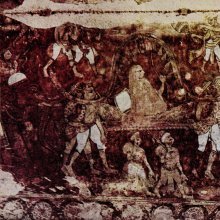Camel: 3 definitions
Introduction:
Camel means something in Buddhism, Pali, the history of ancient India. If you want to know the exact meaning, history, etymology or English translation of this term then check out the descriptions on this page. Add your comment or reference to a book if you want to contribute to this summary article.
Images (photo gallery)
In Buddhism
Tibetan Buddhism (Vajrayana or tantric Buddhism)
Source: academia.edu: The Structure and Meanings of the Heruka MaṇḍalaThe Camel (animal) is associated with the Yoginī (female deity) named Kuṭikā, being situated in the Medinīcakra, according to the 10th century Ḍākārṇava-tantra: one of the last Tibetan Tantric scriptures belonging to the Buddhist Saṃvara tradition consisting of 51 chapters.—Accordingly, the medinīcakra refers to one of the three divisions of the dharma-puṭa (‘dharma layer’), situated in the Herukamaṇḍala. The 36 pairs of Ḍākinīs [viz., Kuṭikā] and Vīras are yellow in color; the shapes of their faces are in accordance with their names [e.g., Camel]; they have four arms; they hold a skull bowl, a skull staff, a small drum, and a knife.

Tibetan Buddhism includes schools such as Nyingma, Kadampa, Kagyu and Gelug. Their primary canon of literature is divided in two broad categories: The Kangyur, which consists of Buddha’s words, and the Tengyur, which includes commentaries from various sources. Esotericism and tantra techniques (vajrayāna) are collected indepently.
India history and geography
Source: Singhi Jain Series: Ratnaprabha-suri’s Kuvalayamala-katha (history)Camels often formed part of a Caravan traveling from city city in ancient India, as depicted in the Kathās (narrative poems) such as Uddyotanasūri in his 8th-century Kuvalayamālā (a Prakrit Campū, similar to Kāvya poetry).—Page 134.32-33 f.: There is a description of a caravan with a large number of camels, bullocks, horses and donkeys. It had come from Vindhyāpurī and was going to Kāñcīpuri.

The history of India traces the identification of countries, villages, towns and other regions of India, as well as mythology, zoology, royal dynasties, rulers, tribes, local festivities and traditions and regional languages. Ancient India enjoyed religious freedom and encourages the path of Dharma, a concept common to Buddhism, Hinduism, and Jainism.
Languages of India and abroad
Nepali dictionary
Source: unoes: Nepali-English DictionaryCamel is another spelling for कमल [kamala].—n. Bot. lotus;
Nepali is the primary language of the Nepalese people counting almost 20 million native speakers. The country of Nepal is situated in the Himalaya mountain range to the north of India.
See also (Relevant definitions)
Starts with: Camel bush, Camel grass, Camel lemon, Camel thorn, Camel thorn bush, Camela, Camelam, Cameli, Cameliattara, Camelina, Camelitela, Camellia, Camellia drupifera, Camellia kissii, Camellia oleifera, Camellia pitardii, Camellia reticulata, Camellia sasanqua, Camellia sinensis.
Query error!
Full-text (+511): Ushtra, Aushtraka, Karabha, Aushtra, Ushtrayana, Kramela, Bholi, Sthulin, Vakragriva, Adhyushtra, Dhumraka, Marudvipa, Marupriya, Mahagriva, Shalabholi, Kalabha, Anushtra, Bhutaghna, Ushtrika, Grivin.
Relevant text
Search found 200 books and stories containing Camel; (plurals include: Camels). You can also click to the full overview containing English textual excerpts. Below are direct links for the most relevant articles:
World Journal of Pharmaceutical Research
Assessment of camel tuberculosis in Ethiopia's pastoral areas. < [2016: Volume 5, January issue 1]
Antimicrobial effects of camel's urine vs. bacteria in wound samples. < [2020: Volume 9, July issue 7]
Corona is culprit of ridiculous offensive nonsense air < [2020: Volume 9, April issue 4]
Rig Veda (translation and commentary) (by H. H. Wilson)
Brihat Jataka by Varahamihira [Sanskrit/English] (by Michael D Neely)
Verse 8.18 < [Chapter 9 - Ashtakavarga]
Verse 27.6 < [Chapter 28 - Conclusion]
Verse 27.10 < [Chapter 28 - Conclusion]
Manusmriti with the Commentary of Medhatithi (by Ganganatha Jha)
Verse 5.8 < [Section II - Objectionable Food]
Verse 8.241 < [Section XXXIX - Disputes between Owner and Keeper]
Verse 5.11 < [Section II - Objectionable Food]
Kathasaritsagara (cultural study) (by S. W. Chitale)
Royal Transport (for journeys or excursions) < [Chapter 2 - Political conditions]
Trade in Ancient India < [Chapter 3 - Economic Conditions]
Dowry System in ancient India < [Chapter 4 - Social Conditions]
Animal Kingdom (Tiryak) in Epics (by Saranya P.S)
